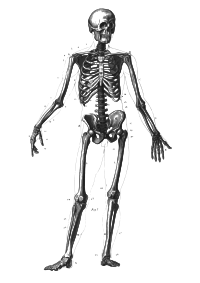Did you know that infants have approximately three hundred bones at birth, but adults have only 206? This is because as we grow, some of the bones fuse together. Of those 206 bones, more than half, or 106, are located in the hands and feet. There are 14 bones in the face and 8 in the cranium, surrounding the brain. The largest and longest bone in the human body is the femur (thigh bone) and the smallest is the stapes which is one of the three small bones in the ear that help us hear. Bones are living tissue with their own nerves and blood vessels. In the average adult, bones account for about 30 to 40% of our body weight and contain about 25% water.
The skeletal system helps protect and support the rest of the body. The bones of the skull form a protective helmet around the brain and the 24 ribs and sternum (breast bone) protect the heart and lungs. The rest of the skeletal system prevents us from being a gelatinous blob by providing support, yet with enough flexibility to enable us to move. If that wasn’t a big enough job, bones also make red and white blood cells in the marrow, store fat and regulate the amount of phosphorous and calcium in the body.
A broken bone is called a fracture and takes about 6 to 8 weeks on average to heal. Depending on the location and severity of the fracture and the age of the individual, healing time can range from 3 weeks (toe) to 10+ weeks (femur). To maintain healthy bones, it is important to stay active and maintain a proper diet with an adequate amount of calcium. Protecting the bones is also important. Wearing a helmet while bike riding and using the proper protective equipment while participating in other sports is essential. The skeletal system is truly an amazing part of the human body. No bones about it!
